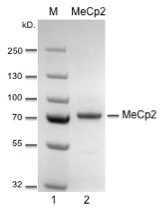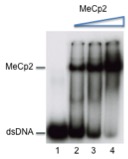|
|
Recombinant MeCp2
|
|---|
 |
 |
|||
|---|---|---|---|---|
| SDS-PAGE gel
of recombinant MeCp2 (Lane 2). Lane 1, protein molecular
weight marker. |
Double strand
methylated
DNA (lane 1) was incubated with increasing amount of recombinant MeCp2
protein (lane 2-4) and run on native PAGE . |
MeCp2 Gel shift assay:
A 70 bp methylated DNA (50 ng) was mixed with competitor
DNA (200
ng), followed by incubation with various amounts of MeCP2 in binding
buffer (50 mM NaCl, 20 mM Tris-Hcl, 0.25 mM EDTA [pH 7.65]) at room
temperature for 30 min. DNA was immediately electrophoresed on 6%
native polyacrylamide gel 0.5× TG (0.025 M Tris, 0.192 M glycine) and
run at room temperature.
Storage:
-80°C
Guarantee:
For research use only. Products guaranteed stable for 2 years from date of receipt when stored properly.
Purity:
>98% purity by SDS PAGE.
Sequence:
MeCp2
(Mw: 52,441 Da.)
MVAGMLGLREEKSEDQDLQGLKDKPLKFKKVKKDKKEEKEGKHEPVQPSAHHSAEPAEAG
KAETSEGSGSAPAVPEASASPKQRRSIIRDRGPMYDDPTLPEGWTRKLKQRKSGRSAGKY
DVYLINPQGKAFRSKVELIAYFEKVGDTSLDPNDFDFTVTGRGSPSRREQKPPKKPKSPK
APGTGRGRGRPKGSGTTRPKAATSEGVQVKRVLEKSPGKLLVKMPFQTSPGGKAEGGGAT
TSTQVMVIKRPGRKRKAEADPQAIPKKRGRKPGSVVAAAAAEAKKKAVKESSIRSVQETV
LPIKKRKTRETVSIEVKEVVKPLLVSTLGEKSGKGLKTCKSPGRKSKESSPKGRSSSASS
PPKKEHHHHHHHSESPKAPVPLLPPLPPPPPEPESSEDPTSPPEPQDLSSSVCKEEKMPR
GGSLESDGCPKEPAKTQPAVATAATAAEKYKHRGEGERKDIVSSSMPRPNREEPVDSRTP
VTERVS
References:
1. Meehan et al., Cell, 58
(1989), pp. 499–507
2. Nan et al., Nature. 1998 May
28;393(6683):386-9.
3. Amir et al., Nat. Genet.
23:185-188(1999).
© 2011-2016 EpiGex. All rights reserved

